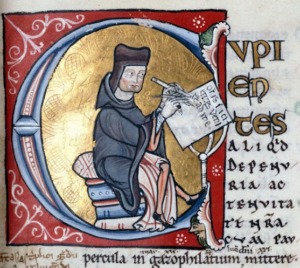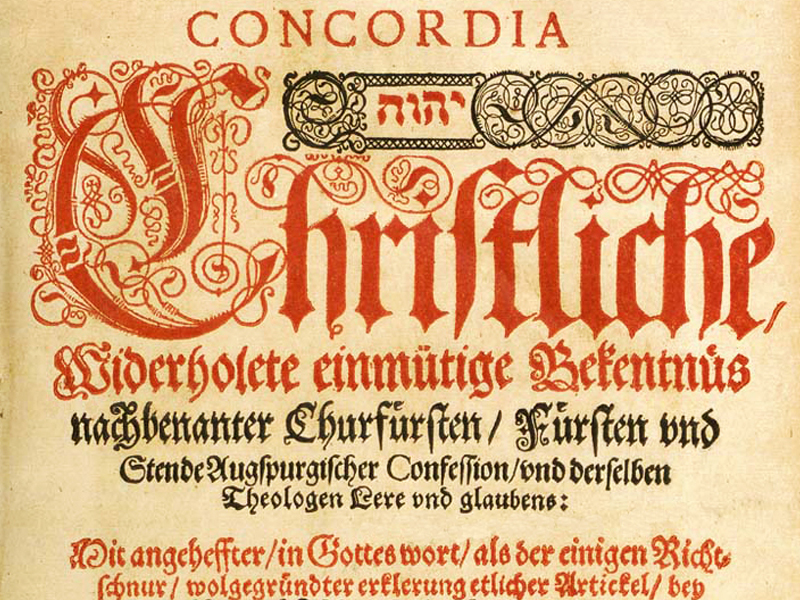by Rev. Aaron Moldenhauer
Arguably the most opaque passage of the Creed is that Christ descended into hell. The passage is based on Scripture, but these scriptural passages (e.g., 1 Peter 3) lend themselves to multiple interpretations about what the descent into hell was, leading to centuries of debate on this article. Which part of Christ descended? To which hell? What did he do there? Is this part of his suffering? This post will briefly consider a few interpretations of the descent into hell—from Peter Lombard, Gabriel Biel, and John Calvin—to better contextualize the Formula of Concord’s brief treatment of the article. Article IX of the Formula, following a sermon of Luther’s, advises that one stick with a simple explanation, taking comfort that Christ has destroyed hell for believers.
Some Interpretations of the Descent

Peter Lombard writes of the descent into hell in his Sentences, the standard medieval textbook of theology. Lombard focuses on what part of Christ descended. Since the body of Christ lay in the tomb during the descent, Lombard argues that Christ descended into hell according to his divinity and his soul while his body remained in the tomb.[1]
Gabriel Biel, in his Commentary on Lombard’s Sentences, besides commenting on what part of Christ descended into hell, raises a different question. What hell did Christ descend to? Biel reports an ancient idea that Christ descended into hell to release the faithful who had died before Christ. In light of this, and with medieval ideas of four levels of hell, Biel agrees that Christ descended to the “upper” two levels of hell: purgatory and the place where saints who had been cleansed in purgatory awaited their redemption. While there, Christ freed these souls from hell. Christ did not descend to limbo or to the deepest hell (the place of the damned), since these souls will never be freed.[2]
Luther, having studied both Lombard and Biel, would have been familiar with these medieval discussions. John Calvin, writing after Luther but before the Formula of Concord, takes a different approach. Calvin, in his Institutes of the Christian Religion, interprets the descent into hell as part of Christ’s suffering. Christ suffered visibly before men, but also invisibly before God. The Creed confesses the invisible part of this suffering—the spiritual torment of Christ’s suffering—with the passage “descended into hell.” Christ speaks of this on the cross when he cries out, “My God, my God, why have you forsaken me?”[3]
The Formula of Concord on the Descent
These treatments of the descent into hell give us context to understand the Formula of Concord’s treatment of the article.[4] The Formula notes that Lutheran theologians debated the article and what it might mean.[5] Their questions parallel those surveyed above: When did Christ descend? In what manner? Before or after his death? Only his soul? Is this part of Christ’s passion, or his victory and triumph?[6]
The Formula recommends avoiding “useless, unnecessary questions” about this article. It is enough to stick with the simplest way, for the matters discussed surpass the ability of reason and the senses to comprehend.[7] Yet, there are necessary points to confess about the article. One ought to know from this article that Christ destroyed hell for all believers and delivered them from death, eternal condemnation, and the jaws of hell. How this happened is an unnecessary question. That it happened is the profitable use of the article.[8]
Luther’s Sermon on the Descent
The Formula of Concord, addressing the descent into hell only briefly, refers readers to a sermon that Martin Luther preached in 1533.[9] In this sermon Luther repeatedly advocates a simple understanding of the words, stressing that the useful reading of the article is that Christ has delivered us from death and hell. As Luther and Lutherans reject belief in places like purgatory or limbo, readings of the descent as Christ’s deliverance of souls from these places are no longer tenable. Rather, the article is read to speak of Christ’s deliverance of all believers from hell. Luther places the descent after Christ’s death, but before his resurrection and ascension.
Luther mocks attempts to debate fruitless questions with his typical sarcasm. Human minds benefit from an image, so we have the image of a descent into hell. But this image should not be taken too literally, Luther says. Christ goes to hell to plant a victory flag, but we should not worry what the banner was made of, or how it did not burn in hell. Rather, Luther advocates sticking to the practical use of the question: Christ has destroyed hell and robbed the devil of all his power.
For Study and Reflection
Behind the Formula’s reading of the descent into hell stand scriptural passages such as 1 Peter 3. 1 Peter 3:18-20 describes Christ preaching to the spirits in prison. This passage suggests that Christ descended to hell to proclaim his victory over Satan and hell. I encourage you to read and study 1 Peter 3-4 in context, and then read Article IX of the Formula of Concord along with Luther’s sermon (cited above). I pray that by this study you find comfort in the victory of Christ over death and hell for you.
The Rev. Aaron Moldenhauer is associate pastor of Zion Lutheran Church, Beecher, Ill.
[1] Peter Lombard, The Sentences: Book 3 On the Incarnation of the Word, trans. Giulio Silano (Toronto: Pontifical Institute of Mediaeval Studies, 2008), 94-95.
[2] Gabriel Biel, Collectoriu circa quattuor libros Sententiarum: Liber Tertius, ed. Wilfridus Werbeck and Udo Hofmann (Tübingen: J.C.B. Mohr (Paul Siebeck), 1979), 350-351.
[3] John Calvin, The Institutes of the Christian Religion, ed. John T. McNeill, trans. Ford Lewis Battles, The Library of Christian Classics, Vol. XX (Philadelphia: The Westminster Press, 1960), 1:515-520.
[4] For further discussion, see Albrecht Peters, Commentary on Luther’s Catechisms: Creed, trans. Thomas H. Trapp (St. Louis: Concordia Publishing House, 2011), 178-185.
[5] For a few instances of this, see Robert Kolb and James A. Nestingen, ed., Sources and Contexts of The Book of Concord (Minneapolis: Fortress Press, 2001), 245.
[6] FC Ep IX.1.
[7] FC Ep IX.2.
[8] FC Ep IX.3.
[9] The sermon, summarized in this and the following paragraph, is found in WA 37:62-72. The section on the descent into hell is found on pages 62-67. An English translation can be found in Kolb and Nestingen, Sources and Contexts of The Book of Concord, 245-255.
